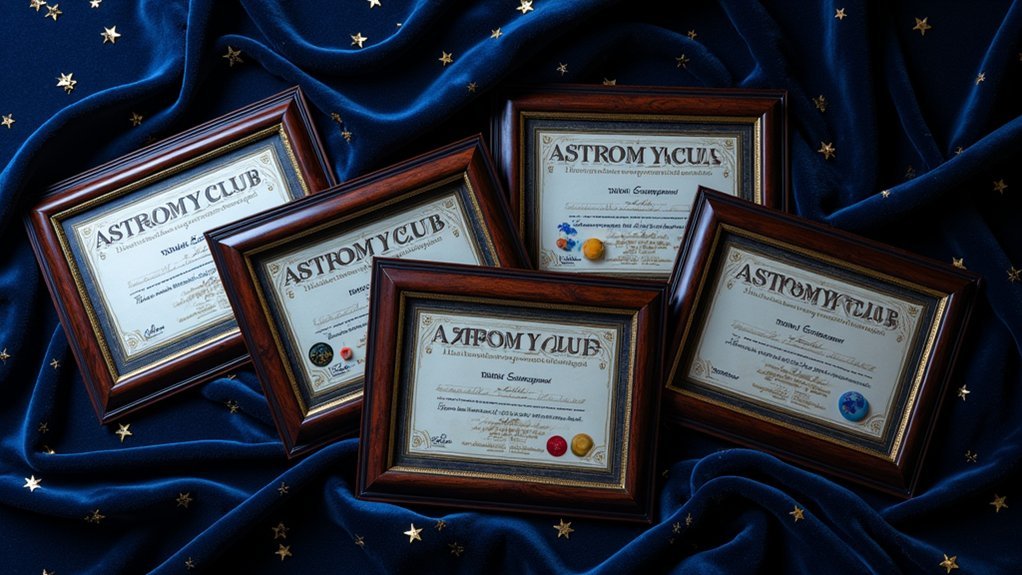Local astronomy club membership typically costs between $20-50 annually, with urban clubs charging $35-45 and rural clubs $25-35. You’ll find student and senior discounts of 25-50% at most organizations. For this affordable fee, you’ll gain access to stargazing events, telescope loaner programs, workshops, and community expertise. Family packages offer additional value, usually costing less than $50 for the entire household. The benefits of these modest fees extend far beyond simple star viewing.
Average Costs: Join Local Astronomy Club Groups

When you’re passionate about stargazing but concerned about expenses, local astronomy clubs offer an affordable entry point into the world of celestial observation. Most clubs charge annual membership fees under $50, making astronomy accessible to enthusiasts on various budgets.
You’ll find many clubs extend discounts to students and seniors, while offering family packages for just a small additional fee. This makes astronomy a cost-effective hobby the whole family can enjoy together.
Beyond the initial membership fees, astronomy clubs provide significant financial benefits. You’ll gain access to dark site locations without additional costs, opportunities to try expensive equipment before purchasing, and connections to members selling used gear at reduced prices.
Astronomy club membership: your gateway to dark skies, equipment testing, and affordable used gear for stargazing on a budget.
These advantages make club membership an economical choice for both beginners and experienced stargazers.
Typical Membership Fee Structures for Astronomy Clubs
You’ll find most local astronomy clubs charge annual dues under $50, making stargazing an affordable hobby for enthusiasts at any budget level.
Many clubs offer family membership options for just a small additional fee, allowing your entire household to enjoy celestial observations together.
Student and senior discounts are commonly available, further reducing the financial barrier to joining your local astronomical community.
Annual Dues Range
The typical membership fees for local astronomy clubs fall between $20 and $50 annually, making stargazing an affordable hobby for enthusiasts of all backgrounds.
Organizations like the North Houston Astronomy Club structure their annual dues range to guarantee accessibility while supporting regular observing sessions and equipment maintenance.
You’ll find these clubs offer several cost advantages:
- Family memberships available for a small additional fee, allowing your whole household to participate
- Student and senior discounts that further reduce the financial commitment
- Access to used equipment markets, helping you save on personal astronomy gear
- Dues that directly fund club activities, assuring you get maximum value from your investment
These affordable membership structures help astronomy clubs remain accessible to anyone with an interest in exploring the cosmos.
Family Membership Options
Most astronomy clubs recognize the communal nature of stargazing by offering family membership plans that extend benefits to your entire household for just $10-$20 more than individual rates. These family membership options keep astronomy an accessible option for everyone, with total annual membership fees typically staying under $50.
| Club Type | Individual Fee | Family Upgrade |
|---|---|---|
| Urban Clubs | $35-45 | +$15-20 |
| Rural Clubs | $25-35 | +$10-15 |
| University-affiliated | $20-30 | +$10 |
| Regional Associations | $40-50 | +$15-20 |
| Special Interest | $30-40 | +$10-15 |
When you opt for family membership, you’ll enjoy identical benefits to individual members—access to meetings, equipment libraries, observing sites, and educational workshops. Many clubs offer additional discounts to students and seniors, making these family packages even more affordable.
Benefits That Justify Club Membership Costs

While astronomy enthusiasts might initially question whether paying for club membership is worthwhile, the value quickly becomes apparent when considering the substantial benefits offered for relatively modest fees.
For less than $50 annually, you’ll gain access to resources that help you observe celestial objects even in areas with light pollution, while maintaining good standing in a community of like-minded stargazers.
Your membership delivers exceptional value through:
- Access to communal expertise that enhances your observational techniques
- Opportunities to purchase quality used equipment at significant discounts
- Participation in organized stargazing events and hands-on workshops
- Use of specialized resources like telescope loaner programs
These benefits allow you to explore astronomy without making substantial investments in equipment while connecting with fellow enthusiasts.
Student and Senior Discount Options
If you’re a student or senior citizen, you’ll find generous discount options at most astronomy clubs, with annual fees often reduced to $25 or less compared to standard rates.
Many clubs also offer family enrollment packages that provide additional savings when multiple household members join together.
For those with limited incomes, special assistance programs may be available to further reduce costs, ensuring astronomy remains accessible to enthusiasts of all financial backgrounds.
Student Pricing Benefits
Local astronomy clubs recognize that students and seniors often operate on tighter budgets, which is why many offer considerable discounts for these groups.
Student discounts typically reduce membership costs by 30-50%, making astronomy accessible during your academic journey.
When you join a club as a student member, you’ll enjoy:
- Noticeably reduced annual fees, often under $25 compared to standard rates
- Access to communal equipment that would be prohibitively expensive to purchase individually
- Opportunities to connect with mentors who can guide your astronomical interests
- Potential savings on used equipment through member-to-member sales
These benefits guarantee that financial constraints don’t prevent you from exploring the cosmos.
Many clubs view student memberships as investments in astronomy’s future, fostering your interest while you’re still developing career paths.
Senior Membership Savings
Many retirees discover that astronomy clubs offer exceptional value through their senior discount programs, typically cutting standard membership costs by 40-50%.
As a senior citizen, you’ll find these discounted membership fees make astronomy an affordable hobby during retirement years.
Most local clubs recognize that fixed incomes require budget-conscious options, offering significant discounts that bring annual dues well below the standard $50 rate.
You’ll benefit from the same full access to club telescopes, observing sessions, and educational resources at half the cost.
These savings extend beyond basic membership fees.
As a senior member, you’ll also gain access to club equipment exchanges where you can purchase used telescopes and accessories at substantial discounts, maximizing your astronomy budget while connecting with like-minded enthusiasts.
Limited-Income Assistance Programs
Astronomy clubs across the country reach out to those with limited income through specialized assistance programs designed to make membership affordable for everyone.
If you’re operating on a tight budget, these programs guarantee the stars remain within your reach:
- Reduced membership fees – Many astronomy clubs offer annual dues under $50, making the hobby accessible regardless of financial constraints.
- Student and senior discounts – Special rates for students and seniors can reduce costs even further, sometimes by 25-50%.
- Family enrollment options – Add family members for a nominal fee, creating an economical way to explore astronomy together.
- Equipment access benefits – Gain connections to used equipment at substantial savings, plus tap into communal resources without purchasing everything yourself.
Family Membership Packages and Savings
Most local astronomy clubs recognize the value of making stargazing a family affair, offering household membership packages that provide excellent value. For just a small additional fee beyond individual membership costs, you’ll gain access to all club activities for your entire household, with annual rates typically staying under $50—making astronomy an affordable option for families with shared interests.
When you join as a family, you’ll enjoy the same benefits as individual members, including workshops, observing sessions, and educational events.
You’ll also find potential savings on used astronomical equipment often available exclusively to members. Many clubs extend additional discounts to families with students or senior citizens, further reducing costs while maximizing the astronomical experiences you can share together.
Equipment Access Through Club Resources

You’ll save thousands on astronomy equipment by joining a local club that offers telescope loaner programs, allowing you to borrow various instruments for up to 90 days.
These shared resources give you hands-on experience with different telescope types before committing to purchases, helping you make informed decisions about which equipment suits your needs.
Club membership also provides opportunities to test specialized astrophotography gear during workshops and star parties, effectively removing the barrier of high upfront costs for newcomers.
Shared Telescope Programs
While purchasing your own astronomy equipment can be expensive, local clubs typically offer shared telescope programs that provide tremendous value for members.
These programs are among the best sources for hands-on experience with quality astronomy equipment without the hefty investment.
Most shared telescope programs offer:
- 30-day loan periods with possible extensions
- Various telescope types including Dobsonian and Newtonian models
- Complementary resources like eyepieces and instructional guides
- Access requiring only club membership in good standing
You’ll save considerably by testing different equipment through these shared resources before committing to any purchases.
This approach allows you to enjoy high-quality stargazing experiences while determining which telescope best suits your needs—all for the price of your annual membership fee.
Hands-On Equipment Trials
Four distinct advantages come with club membership when you’re considering astronomical equipment purchases.
You’ll gain access to various telescopes and equipment to test before investing your money. One of the best benefits is participating in peer equipment testing, where you can evaluate different models based on firsthand experiences rather than just reviews found via email or online forums.
At regular star party gatherings, you can attend workshops featuring hands-on demonstrations of equipment usage and maintenance, developing practical skills while connecting with experienced astronomers.
Additionally, you’ll discover cost-saving opportunities through the club’s internal market, where members frequently sell or trade used gear at favorable prices.
All these equipment trials and resources typically come at no extra cost beyond your annual membership fee, usually under $50.
Cost Comparison: Online vs. In-Person Astronomy Communities
Although both options connect space enthusiasts, online astronomy communities generally offer more budget-friendly participation than traditional local clubs. While you’ll typically pay less than $50 annually for local club membership, online communities often have minimal or no fees.
Consider these value factors when comparing costs:
- Equipment access – Local clubs frequently provide telescope usage and equipment sharing opportunities not available online.
- Special discounts – Students and seniors can often join in-person clubs at reduced rates.
- Used equipment savings – Club connections may lead to deals on secondhand equipment.
- Social benefits – The networking and in-person stargazing experiences provide value beyond monetary considerations.
When calculating true cost, remember that the hands-on experiences and community aspects of local clubs often justify the modest membership fees.
Hidden Expenses to Consider When Joining
Beyond the advertised membership fee, several hidden costs can greatly impact your total investment in an astronomy club.
Transportation expenses to dark sky locations for star parties can add up quickly, especially if these sites are remote.
The journey to stellar vistas often requires more than enthusiasm—fuel costs and travel time demand their own place in your astronomy budget.
You’ll encounter optional fees for specialized workshops and guest speaker events that aren’t covered by basic membership.
While many clubs offer telescope loaner programs, these often require deposits or rental fees.
Don’t overlook the personal equipment investment. You might eventually want your own telescope or binoculars, which can range from a few hundred to several thousand dollars.
Supplementary materials like astronomy books, software, and star charts represent additional costs that enhance your experience but further increase your financial commitment.
Consider these hidden expenses when budgeting for your astronomy hobby.
Annual Dues vs. Lifetime Membership Options
While the hidden costs can influence your overall budget, understanding the actual membership payment structures helps you make fiscally responsible choices.
Most local astronomy clubs offer several payment options to accommodate different financial situations and commitment levels.
- Standard annual memberships typically cost less than $50, making astronomy accessible to most enthusiasts regardless of experience level.
- Family enrollment options add just a small fee to include your spouse and children, maximizing value for households with multiple stargazers.
- Lifetime memberships around $500 eliminate recurring payments and often include voting rights on club decisions and activities.
- Discounted rates for students and seniors make participation more affordable, while membership often provides access to used equipment at reduced prices.
Financial Assistance Programs for Low-Income Enthusiasts
Despite common assumptions about astronomy being an expensive hobby, local clubs have developed numerous financial assistance programs to guarantee the stars remain accessible to everyone.
Many clubs offer reduced annual memberships under $50, with additional discounts for students and seniors.
Affordable memberships as low as $50 unlock celestial exploration, with even lower rates for students and seniors.
You’ll find innovative approaches like “pay what you can” membership models that eliminate financial barriers entirely.
If equipment costs concern you, look into loaner telescope programs that provide access to quality instruments without the significant investment.
Don’t overlook free community outreach opportunities including workshops and public star parties.
Many clubs secure grants and local business sponsorships to subsidize costs, offering free membership or programming to those facing economic challenges.
These initiatives assure your financial situation doesn’t prevent you from exploring the universe.
Regional Variations in Astronomy Club Pricing
As you explore astronomy clubs across different regions of the country, you’ll notice significant pricing variations based on geography, local economic conditions, and available resources.
Understanding these regional differences can help you find the most cost-effective membership option.
- Urban clubs typically charge $40-$50 annually due to higher operational costs but often provide access to advanced equipment and observatory facilities.
- Rural astronomy groups generally offer more affordable rates ($20-$30) though they might’ve fewer resources.
- Coastal regions tend to have higher membership fees but frequently include specialized workshops for marine navigation and astrophotography.
- Midwest and Southern clubs often feature the most competitive family rates, sometimes allowing children under 16 to join for free with a parent’s membership.
Event and Workshop Fees Beyond Basic Membership
Beyond your annual club membership, you’ll encounter various additional costs for specialized astronomy experiences that enhance your stargazing journey.
Special events featuring guest speakers typically range from $5 to $25, depending on the presenter’s expertise and event format.
If you’re looking to develop practical astronomy skills, hands-on workshops cost between $10 and $30, covering necessary materials and resources.
While star parties and outreach events are often free for members, non-members may pay $5 to $15 to participate.
Many clubs offer discounts for students and seniors, making these educational opportunities more accessible.
These additional fees help sustain club operations while providing valuable learning experiences beyond what’s covered in your basic membership, which typically runs under $50 annually.
Evaluating Cost-to-Benefit Ratio for Different Club Tiers
When calculating what you’ll get for your astronomy club investment, it’s essential to compare different membership tiers against your personal stargazing goals.
Most clubs offer tiered options that provide increasing value depending on your commitment level.
- Basic membership ($30-50 annually) – Grants access to monthly meetings, online forums, and member-only viewing events
- Family packages (typically $10-15 additional) – Multiply benefits across household members, dramatically improving value per person
- Student/senior tiers (25-40% discounted) – Offer the same benefits as standard memberships at reduced rates
- Premium memberships ($75-100) – Often include equipment borrowing privileges, advanced workshops, and observatory access
You’ll find the greatest return on investment by selecting a tier that aligns with how frequently you’ll participate and what equipment access you require.
Frequently Asked Questions
What Do You Do in an Astronomy Club?
In astronomy clubs, you’ll observe stars with telescopes, attend educational workshops, learn practical skills, discuss discoveries with fellow enthusiasts, and participate in community outreach events. You’re constantly expanding your knowledge of celestial objects and phenomena.
What Is the Aim of Astronomy Club?
Astronomy clubs aim to spark your interest in astronomy through educational activities and discussions. You’ll enjoy stargazing events, learn from workshops, and join a community of passionate sky-watchers at all experience levels.
Why Should I Join Astronomy?
You should join astronomy because it lets you explore the cosmos, build knowledge through hands-on experiences, and connect with fellow stargazers who’ll support your journey while you discover the universe’s wonders together.
What Is the Best Way to Start Astronomy?
To start astronomy, you’ll benefit most by joining a local astronomy club. You’ll gain mentorship, participate in stargazing events, learn telescope basics, and connect with enthusiasts who’ll guide your journey through the cosmos.
In Summary
You’ll find astronomy club membership fees well worth the investment, typically ranging from $30-$75 annually with discounts for students, seniors, and families. Whether you’ve joined a basic local group or a premium regional organization, the access to equipment, expertise, and community far outweighs the costs. Don’t hesitate to inquire about financial assistance programs if needed—they’re often available to make stargazing accessible to everyone.




Leave a Reply